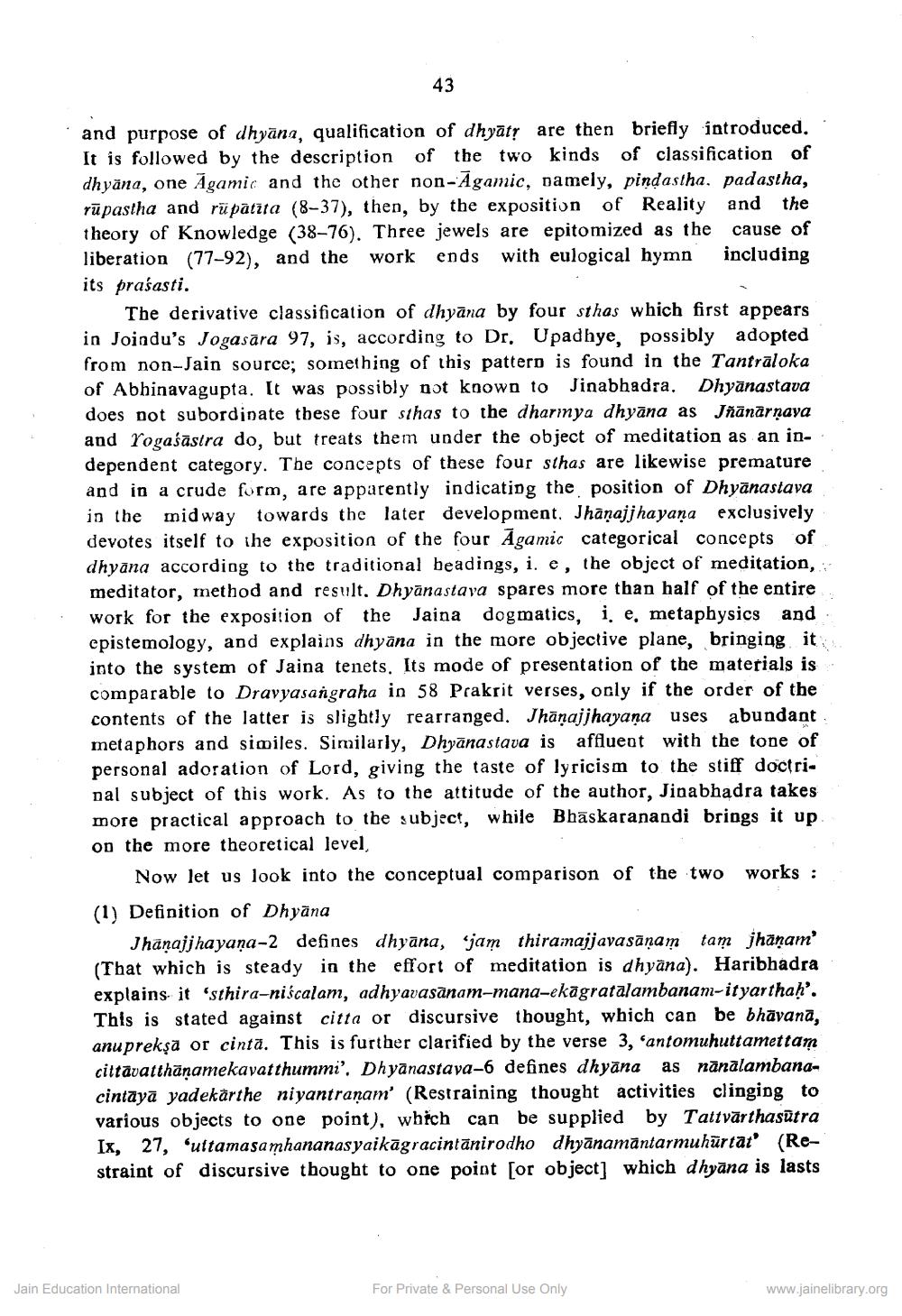________________
43
and purpose of dhyāna, qualification of dhyāt, are then briefly introduced. It is followed by the description of the two kinds of classification of dhyāna, one Agamic and the other non-Agamic, namely, pindastha, padastha, rūpastha and rūpātīta (8-37), then, by the exposition of Reality and the theory of Knowledge (38–76). Three jewels are epitomized as the cause of liberation (77-92), and the work ends with eulogical hymn including its prasasti.
The derivative classification of dhyāna by four sthas which first appears in Joindu's Jogasāra 97, is, according to Dr. Upadhye, possibly adopted from non-Jain source; something of this pattern is found in the Tantraloka of Abhinavagupta. It was possibly not known to Jinabhadra. Dhyānastava does not subordinate these four sthas to the dharmya dhyāna as Jñānārņaya and Yogaśāstra do, but treats them under the object of meditation as an independent category. The concepts of these four sthas are likewise premature and in a crude form, are apparently indicating the position of Dhyānastava in the midway towards the later development. Jhāņajj hayana exclusively devotes itself to the exposition of the four Agamic categorical concepts of dhyāna according to the traditional beadings, i. e, the object of meditation, meditator, method and result. Dhyānastava spares more than half of the entire work for the exposition of the Jaina dogmatics, i e, metaphysics and epistemology, and explains dhyāna in the more objective plane, bringing it into the system of Jaina tenets. Its mode of presentation of the materials is comparable to Dravyasangraha in 58 Prakrit verses, only if the order of the contents of the latter is slightly rearranged. Jhānajjhayana uses abundant metaphors and similes. Similarly, Dhyānastava is affluent with the tone of personal adoration of Lord, giving the taste of lyricism to the stiff doctrinal subject of this work. As to the attitude of the author, Jinabhadra takes more practical approach to the subject, while Bhaskaranandi brings it up on the more theoretical level,
Now let us look into the conceptual comparison of the two works : (1) Definition of Dhyāna
Jhanajjhayana-2 defines dhyāna, jam thiramajjavasāņam tam jhanam' (That which is steady in the effort of meditation is dhyāna). Haribhadra explains it 'sthira-niścalam, adhyavasānam-mana-ekāgratalambanam-ityarthah'. This is stated against citta or discursive thought, which can be bhāvanā, anuprekşā or cinta. This is further clarified by the verse 3, 'antomuhuttamettan cittavatthānamekavatthummi'. Dhyānastaya-6 defines dhyāna as nānalambanacintayā yadekarthe niyantranam' (Restraining thought activities clinging to various objects to one point), which can be supplied by Tattvārthasūtra Ix, 27, 'uttamasamhananasyaikāgracintānirodho dhyānamāntarmuhūrtat (Restraint of discursive thought to one point for object] which dhyāna is lasts
Jain Education International
For Private & Personal Use Only
www.jainelibrary.org




